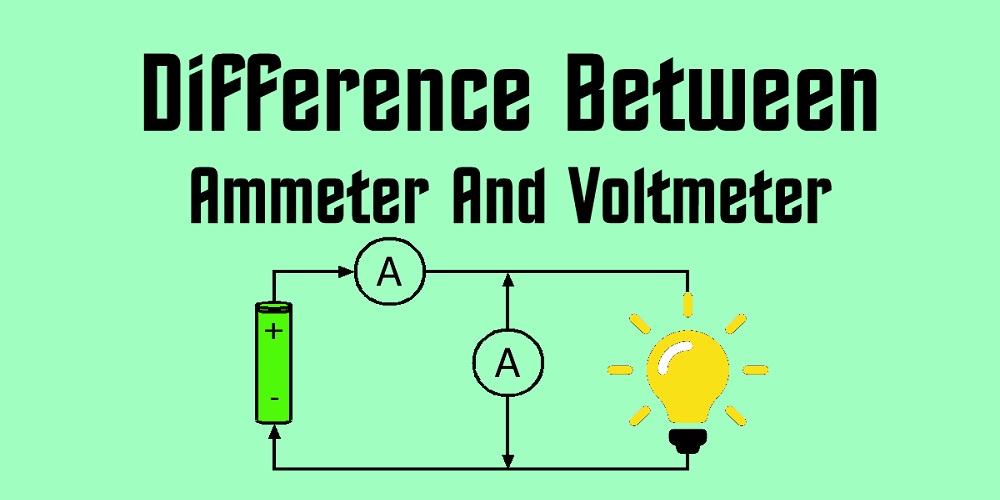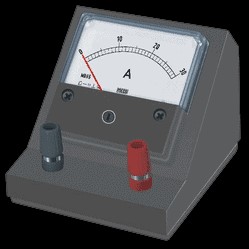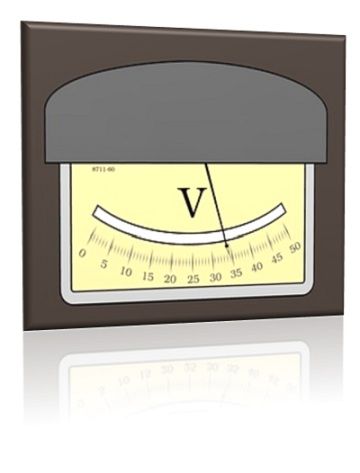Welcome to Linquip again! In this article, we are going to discuss the core Difference Between Voltmeter and Ammeter. Buckle up and keep reading.
To understand the difference between a voltmeter and an ammeter, first, we should learn what an ammeter is and how it functions.
What is an Ammeter?
The electric current has the SI unit of Ampere, hence its measuring tool is named Amperemeter or simply Ammeter. Even though there are two types of current: Alternating Current and Direct Current, the ammeter has no problem with measuring both.
What Does an Ammeter Measure?
The ammeter is used to measure the electric current in the electric circuit, measured by Ampere (A).
How Does an Ammeter Work
The ammeter is designed to measure the electric current in a circuit.
How does it work?
The ammeter will measure the current flowing through a set of coils with very low resistance and inductive reactance. The impedance needs to be kept in a very small number so that the ammeter won’t change the current value because of its extra impedance.
The image above is a moving-coil ammeter and we often call it an analog ammeter. Inside it, there are fixed magnets that are designed to oppose the electric current flowing through it. Its indicator pointer is moved by an armature, placed in the center of the magnet (similar to the simple dc motors). The pointer is positioned in a fine place with the scale and number on the display screen.
The most important thing about any measurement tool is it shouldn’t change the variable values in the circuit. The voltmeter, ammeter, and ohmmeter are prohibited to change the voltage, current, and resistance inside the circuit.
To choose the right equipment and understand the Difference Between Voltmeter and Ammeter, it is vital for you to know how each one functions and which one suits you best.
Frequently Asked Questions
How does the ammeter measure current?
The ammeter will measure the current flowing through a set of coils with very low resistance and inductive reactance. The impedance needs to be kept in a very small number so that the ammeter won’t change the current value because of its extra impedance.
What do ammeters and voltmeters measure?
An ammeter is used to measure electric current while a voltmeter is used to measure electric voltage.
What is the principle of an ammeter?
The impedance needs to be kept in a very small number so that the ammeter won’t change the current value because of its extra impedance.
Do ammeters have high resistance?
The resistance needs to be kept in a very small number so that the ammeter won’t change the current value because of its extra resistance.
Now, to understand the Difference Between a Voltmeter and an Ammeter, we are going to explain what a Voltmeter is and then compare it to an Ammeter.
What is a voltmeter?
A Voltmeter is an instrument that measures voltages of either direct or alternating electric current on a scale usually graduated in volts, millivolts (0.001 volts), or kilovolts (1,000 volts). Many voltmeters are digital, giving readings as numerical displays.
Voltmeters can also provide readings in analog form, by moving a pointer that indicates voltage on a scale, but digital voltmeters generally have a higher order of accuracy than analog instruments.
Working Principle of Voltmeter
The main principle of a voltmeter is that it must be connected in parallel when we want to measure the voltage. A parallel connection is used because a voltmeter is constructed in such a way that it has a very high value of resistance. So if that high resistance is connected in series then the current flow will be almost zero which means the circuit has become open.
If it is connected in parallel, then the load impedance comes parallel with the high resistance of the voltmeter, and hence the combination will give almost the same impedance that the load had. Also in the parallel circuit, we know that the voltage is the same so the voltage between the voltmeter and the load is almost the same and hence voltmeter measures the voltage.
For an ideal voltmeter, the resistance is to be infinity, and hence the current drawn is to be zero so there will be no power loss in the instrument. But this is not achievable practically as we cannot have a material that has infinite resistance.
We have explained the features of the voltmeter and ammeter. Now let’s take a look at this table and compare the core Difference Between Voltmeter and Ammeter.
Difference Between Voltmeter and Ammeter
| PARAMETERS | VOLTMETER | AMMETER |
| Definition | A measuring instrument that measures the voltage difference between two points. | A measuring instrument that measures the current flowing in the circuit. |
| Connection | Connected in parallel | Connected in series |
| Unit of Scale Calibrated | Scale is calibrated in volts | Scale is calibrated in Ampere |
| Ideal Resistance | Infinite | Zero |
| Practical Resistance | High resistance as compared to an Ammeter | Very low resistance as compared to Voltmeter |
| Accuracy | Less accurate than the Ammeter | More accurate as compared to Voltmeter |
Conclusion
The voltmeter measures the voltage difference between two points in the circuit while the ammeter measures the current flowing through the circuit. If we want to measure the current flowing through the load, we need to connect the ammeter in series with the load. While if we want to measure the voltage across the load, we need to connect a voltmeter in parallel with the load.
Now you know the core Difference Between a Voltmeter and Ammeter.
Hope you enjoyed the article! You can find similar content on Linquip, a professional network for equipment manufacturers, industrial customers, and service providers.
Buy Equipment or Ask for a Service
By using Linquip RFQ Service, you can expect to receive quotations from various suppliers across multiple industries and regions.
Click Here to Request a Quotation From Suppliers and Service Providers
Read More On Linquip
- Difference Between Potentiometer and Voltmeter
- Difference Between Multimeter and Voltmeter
- Difference between Petrol and Diesel Engine: An Easy-To-Understand Comparison
- Difference Between Safety Valve and Relief Valve
- Generator vs Inverter: What’s the Main Difference
- The Difference Between Prime & Standby Generators
- Difference Between Fuse and MCB: A Comprehensive Guide






